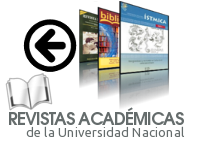¿Pueden los micetozoos ser usados como indicadores de salud del suelo en el contexto agrícola de Costa Rica?
DOI:
https://doi.org/10.15359/rca.52-1.9Palabras clave:
biosistemas, caña de azúcar, dictiostélidos, mixomicetes, mixogástridosResumen
El estudio de las poblaciones de micetozoos en agroecosistemas con diversas características y grados de disturbio por actividades antropogénicas es un tema con escasa investigación en el nivel mundial. Con el objeto de estudiar esta interacción, nosotros documentamos la incidencia de dos grupos de micetozoos (mixogástridos y dictiostélidos) en dos sistemas agrícolas de caña de azúcar y piña en Costa Rica. Para cada sistema de estudio cuantificamos una serie de variables edáficas, químicas y paisajísticas. Tras el análisis, encontramos que, para ambos grupos, tres variables explicaron el 99 % de la variabilidad de incidencia de estos. Para los dictiostélidos las variables fueron porcentaje de arcilla, pH y Biomasa microbiana. En el caso de los mixogástridos, estas variables fueron el Manganeso, respiración microbiana y pH. Los resultados anteriores señalan un potencial medio de uso de micetozoos como indicadores ambientales, en tanto el efecto de los sistemas de cultivo sobre la actividad de los microorganismos fue cuantificable. Sin embargo, consideramos que se requiere todavía definir el papel de las diferentes variables medidas sobre la dinámica de ambos grupos de microorganismos para poder establecer una conclusión con potencial aplicación, apoyada por datos empíricos.Referencias
Bunning, S., & Jimenez, J. (2003). Indicators and Assessment of Soil Biodiversity/Soil Ecosystem Functioning for Farmers and Governments. In OECD Expert Meeting on indicators of Soil Erosion and Soil Biodiversity. Rome.
Cardoso, E. J. B. N., Vasconcellos, R. L. F., Bini, D., Miyauchi, M. Y. H., Santos, C. A. dos, Alves, P. R. L., … Nogueira, M. A. (2013). Soil health: looking for suitable indicators. What should be considered to assess the effects of use and management on soil health? Scientia Agricola, 70(4), 274-289. doi: 10.1590/S0103-90162013000400009
Cavalier-Smith, T., Fiore-Donno, A. M., Chao, E., Kudryavtsev, A., Berney, C., Snell, E. A., & Lewis, R. (2015). Multigene phylogeny resolves deep branching of Amoebozoa. Molecular Phylogenetics and Evolution, 83, 293-304. doi: 10.1016/j.ympev.2014.08.011
Clark, J., & Ef, H. (2015). Myxomycete plasmodial biology: a review, 6(October), 643-657. doi: 10.5943/mycosphere/6/6/1
Crowley, D. E., y Alvey, S. A. (2002). Regulation of microbial processes by soil pH. In: Z. Rengel, (Ed.). Handbook of Plant Growth: pH as the Master Variable. EE. UU.: Marcel Dekker.
Díaz-Romeu, R. y Hunter, A. (1982). Metodología de muestreo de suelos, análisis químico de suelos y tejido vegetal y de investigaciones en invernadero. Turrialba: CATIE.
Dubey, R. K., Tripathi, V., & Abhilash, P. C. (2015). Book Review: Principles of Plant-Microbe Interactions: Microbes for Sustainable Agriculture. Frontiers in Plant Science, 6(November), 1-448. doi: 10.3389/fpls.2015.00986
Eldor, P. (2015). Soil Microbiology, Ecology, and Biochemistry. In Soil Microbiology, Ecology and Biochemistry (pp. 1-14). Elsevier. doi: 10.1016/B978-0-12-415955-6.00001-3
Esteban, G. F., Finlay, B. J., & Warren, A. (2014). Free-Living Protozoa. Thorp and Covich’s Freshwater Invertebrates: Ecology and General Biology: Fourth Edition, 1, 113-132. doi: 10.1016/B978-0-12-385026-3.00007-3
Feest, A., & Stephenson, S. (2014). The response of myxogastrids to soil amendments, 5 (November), 821-829. doi: 10.5943/mycosphere/5/6/12
Fiore-Donno, A. M., Nikolaev, S. I., Nelson, M., Pawlowski, J., Cavalier-Smith, T., & Baldauf, S. L. (2010). Deep Phylogeny and Evolution of Slime Moulds (Mycetozoa). Protist, 161(1), 55-70. doi: 10.1016/j.protis.2009.05.002
Hastie, T., Tibshirani, R., & Friedman, J. (2009). The Elements of Statistical Learning: Data Mining, Inference, and Prediction. Elements, 1, 337-387. doi: 10.1007/b94608
Henríquez, C., Bertsch, F., & Salas, R. (1995). Fertilidad de suelos: manual de laboratorio. San José: Asociación Costarricense de la Ciencia del Suelo.
Hoppe, T., & Schnittler, M. (2015). Characterization of myxomycetes in two different soils by TRFLP- analysis of partial 18S rRNA gene sequences, 6(April), 216-227. doi: 10.5943/mycosphere/6/2/11
Jenkinson, D. S., & Powlson, D. S. (1976). The effects of biocidal treatments on metabolism in soil—V. Soil Biology and Biochemistry, 8(3), 209-213. doi: 10.1016/0038-0717(76)90005-5
Kaleita, A. L., Schott, L. R., Hargreaves, S. K., & Hofmockel, K. S. (2017). Differences in soil biological activity by terrain types at the sub-field scale in central Iowa US. PLoS ONE, 12(7), 1-13. doi: 10.1371/journal.pone.0180596
Keller, H. W., & Everhart, S. E. (2010). Importance of Myxomycetes in Biological Research and Teaching. Papers in Plant Pathology of the University of Nebraska-Lincoln, 3(1), 13-27. Recuperado de http://ever77.myweb.uga.edu/Publications/Everhart_2010_ImportanceofMyxomycetes.pdf
Kryvomaz, T., & Stephenson, S. (2017). Preliminary evalution of the possible impact of climate change on myxomycetes. Papers in Plant Pathology of the University of Nebraska-Lincoln, 104(1), 5-30. doi: 10.1127/nova_hedwigia/2016/0379
Mueller, U. G., & Sachs, J. L. (2015). Engineering Microbiomes to Improve Plant and Animal Health. Trends in Microbiology, 23(10), 606-617. doi: 10.1016/j.tim.2015.07.009
Pimentel, M. (2007). Manipulating Ecosystems for Agriculture. In Food, Energy, and Society, Third Edition (pp. 37-44). CRC Press. doi: 10.1201/9781420046687.ch5
Rojas, C., & Kryvomaz, T. (2017). Myxomycetes in the 21st Century. In C. Rojas & S. Stephenson (Eds.), Myxomycetes: Biology, Systematics, Biogeography and Ecology. Academic Press.
Romeralo, M., Escalante, R., & Baldauf, S. L. (2012). Evolution and Diversity of Dictyostelid Social Amoebae. Protist, 163(3), 327-343. doi: 10.1016/j.protis.2011.09.004
Spiegel, F., Haskins, E. F., Cavender, J. C., Landolt, J. C., Lindley-settlemyre, L. A., Edwards, S. M., … Shadwick, J. D. (2005). A beginner’s guide to isolating and culturing eumycetozoans. Retrieved from papers://560067a4-156f-4d6d-b6cc-2f64c208798b/Paper/p167
Stephenson, S. L., Fiore-Donno, A. M., & Schnittler, M. (2011). Myxomycetes in soil. Soil Biology and Biochemistry, 43(11), 2237-2242. doi: 10.1016/j.soilbio.2011.07.007
Swanson, A. R., Vadell, E. M., & Cavender, J. C. (1999). Global distribution of forest soil dictyostelids. Journal of Biogeography, 26(1), 133-148. doi: 10.1046/j.1365-2699.1999.00250.x
Tibshirani, R. (1996). Regression Shrinkage and Selection via the Lasso. Journal of the Royal Statistical Society B, 58(1), 267-288. Recuperado de https://statweb.stanford.edu/~tibs/lasso/lasso.pdf
Vance, E. D., Brookes, P. C., & Jenkiinson, D. S. (1987). An Extraction Method for Measuring Soil Microbial Biomass C. Soil Biology and Biochemistry, 19(6), 703-707. doi: 10.1016/0038-0717(87)90052-6
Wang, X., Liu, L., Piao, S., Janssens, I. A., Tang, J., Liu, W., … Xu, S. (2014). Soil respiration under climate warming: differential response of heterotrophic and autotrophic respiration. Global Change Biology, 20(10), 3229-3237. doi: 10.1111/gcb.12620
Whiting, D., Wilson, C., & Card, A. (2002). Estimating Soil Texture Sandy, Loamy, or Clayey? Colorado Master Gardener. Program Colorado Gardener Certificate Training CMG Fact Sheet #S14, (December 2003), 1-7.
Zhou, L., Zhou, X., Zhang, B., Lu, M., Luo, Y., Liu, L., & Li, B. (2014). Different responses of soil respiration and its components to nitrogen addition among biomes: a meta-analysis. Global Change Biology, 20(7), 2332-2343. doi: 10.1111/gcb.12490
Publicado
Cómo citar
Número
Sección
Licencia
A partir del 17 de mayo del 2018 la licencia ha sido actualizada a:

Esta obra está bajo una Licencia Creative Commons Atribución-NoComercial-CompartirIgual 4.0 Internacional.


















